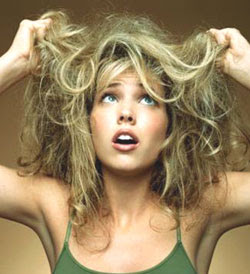 Oily hair is a drag, but dry hair is no picnic, either. Dry hair is dull hair, and it looks the same after you wash it as it did before. Everyone has bad hair days, but with dry hair you may have those days more often than not.
Oily hair is a drag, but dry hair is no picnic, either. Dry hair is dull hair, and it looks the same after you wash it as it did before. Everyone has bad hair days, but with dry hair you may have those days more often than not.
Along with dry hair, you may also have a dandruff problem. Although it's more often a condition associated with oily hair, people with dry hair get dandruff, too. Common dandruff is simply a layer of skin shedding from your scalp. When the skin cells get trapped on your scalp by your hair and clump together, you have dandruff. And dandruff can make your hair look dull.
Dry hair can result from external factors, such as exposure to harsh chemicals, or from internal causes, such as an illness. These are the primary external factors for those lackluster locks:
- Harsh shampoo
- Shampooing too often greeencoffenews.co.uk
- Hair dye
- Hair perms
- Chlorine in swimming pools and hot tubs
- Overuse of the blow dryer or curling iron
- Too much exposure to sun and wind
- High mineral content in local water supplies
- External factors are easy to remedy. You just need to be careful about how you treat your hair, cutting back on activities that cause it to become dry. Switch products. Wear a cap when swimming. Cover your head when you're outside in the sun for prolonged periods. And use the kitchen cures in this profile.
Internal factors, though, don't have quite such a quick fix. Internal factors that cause dry hair include:
- Cancer treatment
- Certain medications
- Nutritional deficiency
- Prolonged illness
Before you start to panic, go to the next page and read all the simple home remedies for dry hair. Chances are you'll find something that will put the luster back in your locks.
source:http://health.howstuffworks.com

